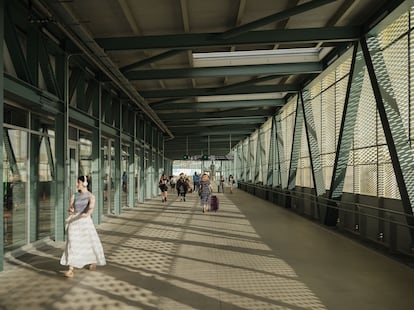Almost 75 years ago, the train arrived in Santiago de Compostela without approaching the center. The station, extramurous, forced that neighborhoods of the South, such as Pontepedriña, would be separated from the rest of the city. However, says the architect Juan Herreros, that condition “saved the natural area of the Brañas del Sar.” That ecological heritage today, with the new station, has approached the city. Because?
The international competition that Herreros and its study won in 2011 to lift the new high -speed station explained that the new building should fly over the platforms, attached to a generous catwalk – existent and rethink – that was going to fulfill a double function: access to the station, connection and citizen step. In an exercise of remarkable political collaboration, the new infrastructure should serve to update rail services and, in turn, to facilitate people’s displacements.
The train, in this project, acts as a connector element, despite the ambiguous nature of the tracks, which disconnect to connect.
On the ground, the architects paid attention to a fact: most travelers arrived at the walking station. That decided to locate the new station in the same level as the city. They took that idea by decontextualizing another architectural typology: airports. Thus, the exit zone that flies over the airplane parking areas, is here access. And, also as in airports, access to trains is done by catwalks that guarantee order and safety.
With universal accessibility and elevators with space to transport bicycles, the architecture of the new station causes the change of dimension to seem simple. Herreros speaks of “an organic form that retracts the program without compositional concessions.” And it is true that the resulting infrastructure is so apparently light – it is lifted with industrialized simple assembly systems – as solid – located on a large platform of pillars and concrete slabs.
The result is a great infrastructure that, having been designed with perforated and translucent materials, does not seem to weigh and proves to be more concerned with guiding and accompanying travelers and facilitating the daily life of citizens than to impose their presence. That translucent aspect – to catch as much natural light possible – and not to mark the place has been achieved thanks to the use of perforated metal panels completed with zinc covers that pay tribute, blacksmiths points out, to a system that the Galician industry is a toe. The interiors echo this search for natural light to make the wait for more light.

